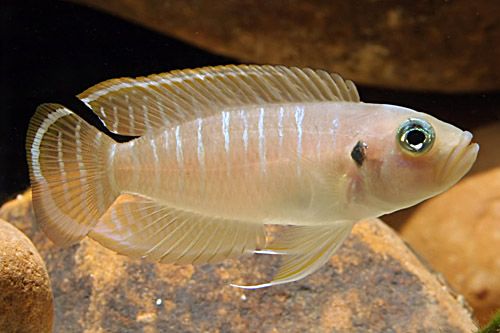Hi my name is Ben Brevis and this is my mate Brenda. As mentioned above we are Neolamprologus brevis, also known by our friends as Brevis Sunspots.

Now a bit about our family if I may. Our ancestors emigrated originally from Lake Tanganyika, Africa, but for many years now my parents and theirs have lived here in North America. In Lake Tanganyika our breed usually inhabits the muddy and sandy areas of the lake where you will find a large number of snails. We are shell dwellers you see, and will often be found inhabiting the empty houses of these snails where we will spawn and hide from predators. Normally we can be found in water depths of 6 to 55 meters. Within our breed it is difficult to tell the males from the females but if you look real close you will notice that the males are usually larger and have a clearly pronounced orange fringe on the upper edge of the dorsal fin. You will not find a great many plants growing where our brother cichlids live but we, the Brevis, do like some small plants in our breeding environment.
I would like to touch upon a delicate subject here if I may. When Brenda is ready for spawning she nudges me in the side and then disappears into a shell with only her tail fin showing. Next I follow her in and position myself over the eggs that she has laid in the shell, and fertilize them while I shiver. No Im not cold, its just the way it happens. We usually have from 15 to 30 eggs, but I am not allowed to remain as Brenda will chase me out of the maternity ward shell while she takes very good care of our soon to be family. In about six days the youngsters are free swimming and I get to swim and frolic with them as we explore our environment.
Now let me tell you a bit about our specific environment. We have a very good Landlord who has provided us with a five gallon aquarium to live in. It has a glass top and the bottom is covered with approximately 1.5 to 2 inches of silica sand and has several mixed size, live plants growing in it. We have our main bungalow shell, and two or three other guest shells which we can visit or which the children can play in when theyre ready. Of course when they grow up they will have the use of these guest bungalow shells for their own accommodations and spawning.
We have a corner filter back there in the corner with lots of aeration bubbling out of it and enjoy a ten percent or more water change each week. At the price of heating these days I am pleased to say that our Provider keeps our accommodations at a temperature of 23.5 to 27.5 degrees Celsius without any cost to us. We have incandescent lighting that gives us sufficient illumination when outside our shell accommodations.
Food, oh yes. Well, our Provider feeds us twice a day with a variety of flake food and mixed fry food in the morning and something more substantial each evening. Our diet for our evening meals consists of one of the following: frozen beef heart, frozen shrimp, frozen blood worm, freeze-dried blood worm, freeze-dried tubifex worms, mosquito larva, plankton, krill, pellets, gamarus and each week after our water change we are fed live baby brine shrimp – boy do they hit the spot. We even get some fry food for our youngsters when necessary. You may think that this is a very rich diet and maybe you’re right, but our Provider seems to enjoy what he is doing for us, so we show him our appreciation by growing fat and saucy and raising lots of young ones for him. Initially we had a great many small sand snails living in here with us but the Provider and his Lady took exception to their proliferation and cleaned them out. Now there arent any left and Im not sure if that might affect our breeding cycle. You see we have had four spawnings in a row while they were here.
Well I must go now; Brenda has just called me to look after the youngsters while she goes for a swim. Take care now and have a good day.
Leave a Reply